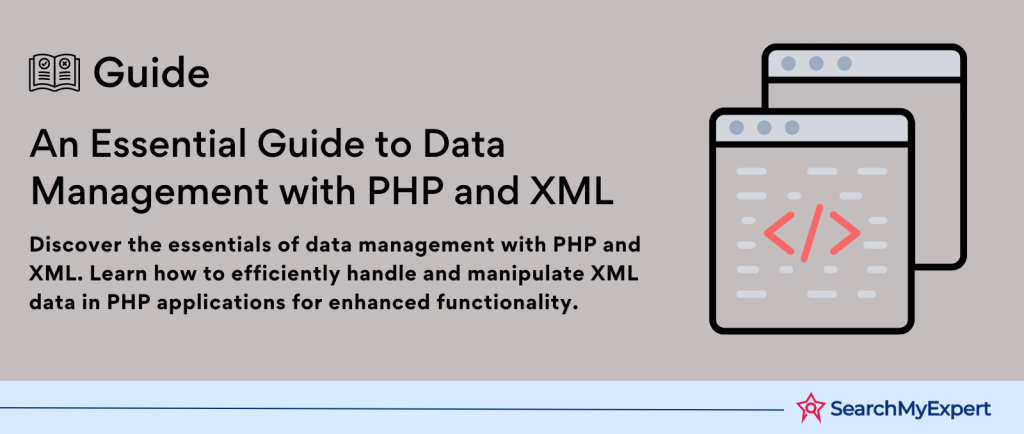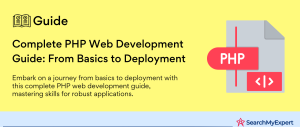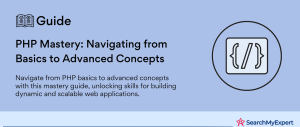PHP and XML: Data Management
PHP: The Powerhouse of Web Development
PHP, a server-side scripting language, is a titan in web development. Known for its ease of use and flexibility, PHP powers countless websites and applications. It’s perfect for dynamic content and database interactions, making it a go-to choice for developers.
Key Strengths of PHP:
- Versatility:
PHP seamlessly integrates with various databases. - Ease of Learning: Its syntax is straightforward, especially for beginners.
- Flexibility: PHP scripts can run across all operating systems.
XML: The Structured Data Maestro
XML, or Extensible Markup Language, excels in data representation and transfer. It’s all about structure and standardization, ensuring data is not only readable but also universally understandable.
Core Advantages of XML:
- Platform-Independent: XML data can be used across different systems.
- Self-Descriptive: Its tree-like structure is both human and machine-readable.
- Flexible: Can represent complex data structures, ideal for various applications.
Together, a Dynamic Duo
Combining PHP and XML? That’s where magic happens. This duo brings flexibility, portability, and a robust structure to data management.
The Combined Benefits:
- Seamless Data Exchange:
PHP’s backend capabilities with XML’s data structuring create a powerful data management framework. - Flexibility and Adaptability: Tailor-made solutions for diverse data needs.
- Portability: Share data across platforms without a hitch.
Real-World Applications: PHP and XML in Action
Let’s look at some scenarios where PHP and XML shine together in data management:
- Content Management Systems (CMS): PHP-driven CMS like WordPress use XML for data storage and transfer, ensuring a smooth user experience.
- Web Services:
APIs often use XML, and PHP scripts handle the data, providing an efficient way to exchange information between different systems. - E-commerce Platforms:
Managing product catalogs, often stored in XML format, while PHP handles user interactions and transactions.
PHP and XML together offer a comprehensive solution for managing data efficiently and effectively. Their synergy in various real-world scenarios demonstrates their capability to handle complex data management tasks with ease.
Understanding XML Data Structure
The Blueprint of XML Documents
XML, or Extensible Markup Language, is the cornerstone of structured data exchange. It’s all about precision, organization, and clarity.
Basic Syntax: The Building Blocks
- Elements:
The primary component, wrapped in angled brackets, <element>. - Root Element:
Every XML document has one root element, encapsulating all other elements. - Closing Tags: For every opening tag <tag>, a closing tag </tag> is a must.
Dive into Key Elements
Understanding XML’s key elements is like unlocking a treasure chest of data management potential.
Tags: The Labels of Data
- Role:
Define the start and end of data elements. - Nesting: Tags can contain other tags, forming a tree-like structure.
Attributes: Adding Context
- Purpose: Provide additional information about elements.
- Syntax: Written within the opening tag, e.g., <employee id=”123″>.
Nodes: The Essence of XML
- Types: Element, attribute, text, and more.
- Hierarchy: Parent-child relationships form the backbone of XML’s structure.
Representing Data Types
XML’s versatility shines in its ability to represent various data types.
Examples:
- Textual Data: Enclosed within tags, like <name>John Doe</name>.
- Numerical Data: Similarly enclosed, e.g., <age>30</age>.
- Lists: Using nested elements, <fruits><fruit>Apple</fruit><fruit>Banana</fruit></fruits>.
- Complex Structures:
Combining elements and attributes for detailed data representation.
Understanding XML’s data structure is fundamental for effective data management. Its flexible yet structured approach makes it an invaluable tool in the realm of data representation.
Parsing XML Data with PHP
Navigating XML with PHP: A Trio of Techniques
PHP offers a range of tools for XML parsing, each tailored for specific scenarios. Let’s delve into three primary methods: SimpleXML, DOM, and SAX.
SimpleXML: The Easy Navigator
- Functionality: Transforms XML into an object, enabling direct access to elements.
- Advantages: Ideal for beginners or simple XML files, SimpleXML offers a straightforward approach.
Example Code:
php
$xml = simplexml_load_file(‘example.xml’);
echo $xml->title;
DOM: The Precision Editor
- Functionality:
Treats XML as a tree of nodes, allowing for deep manipulation and complex operations. - Advantages:
Perfect for intricate XML documents; offers full control over the document’s structure.
Example Code:
php
$dom = new DOMDocument();
$dom->load(‘example.xml’);
$title = $dom->getElementsByTagName(‘title’)->item(0)->nodeValue;
echo $title;
SAX: The Efficient Processor
- Functionality:
Parses XML data as a stream, triggering events as it encounters tags. - Advantages: SAX is memory-efficient and suitable for large XML files, making it a practical choice for resource-intensive tasks.
Example Code:
php
function startElement($parser, $name, $attrs) { /*…*/ }
function endElement($parser, $name) { /*…*/ }
$parser = xml_parser_create();
xml_set_element_handler($parser, “startElement”, “endElement”);
xml_parse($parser, file_get_contents(‘example.xml’));
xml_parser_free($parser);
Choosing Your Path
Each PHP XML parsing method has its unique strengths. SimpleXML for simplicity and quick access, DOM for detailed manipulation, and SAX for efficient processing of large files. Selecting the right approach depends on your specific data handling needs.
This section covers different methods for parsing XML data in PHP, including SimpleXML, DOM, and SAX. Each method is explained with its functionality and advantages, accompanied by code examples for basic parsing tasks.
Manipulating XML Data with PHP
Mastering XML Data Manipulation in PHP
PHP not only excels at parsing XML but also provides robust tools for manipulating XML data. Let’s explore how to access, traverse, and modify XML elements and attributes, and how to create new XML documents from PHP data structures.
Accessing and Traversing XML Elements
- Methods: SimpleXML and DOM offer direct ways to access and iterate through XML elements and attributes.
- Techniques:
Use loops and PHP’s array-like syntax to traverse XML structures.
Example with SimpleXML:
php
$xml = simplexml_load_file(‘example.xml’);
foreach ($xml->book as $book) {
echo $book->title . “, ” . $book->author . “<br>”;
}
Modifying XML Data
PHP makes it straightforward to add, remove, or update XML elements.
- Adding Elements: Use addChild() in SimpleXML or createElement() in DOM.
- Removing Elements:
Unset elements in SimpleXML or use removeChild() in DOM. - Updating Elements: Directly assign new values in SimpleXML or update node values in DOM.
Example with DOM:
php
$dom = new DOMDocument();
$dom->load(‘example.xml’);
$newElement = $dom->createElement(‘genre’, ‘Fiction’);
$dom->documentElement->appendChild($newElement);
$dom->save(‘example_modified.xml’);
Generating New XML Documents
PHP can convert data structures into XML documents, useful for creating feeds, storing data, or API responses.
- Method:
Construct elements and attributes using DOM functions. - Advantage: Offers flexibility to create complex XML structures from various data types.
Example Code:
php
$dom = new DOMDocument();
$root = $dom->createElement(‘books’);
$dom->appendChild($root);
foreach ($booksArray as $book) {
$bookElement = $dom->createElement(‘book’);
$bookElement->setAttribute(‘id’, $book[‘id’]);
$root->appendChild($bookElement);
}
$dom->save(‘new_books.xml’);
Tailoring XML to Your Needs
Whether it’s traversing, modifying, or creating XML documents, PHP provides the tools and functions to handle XML data efficiently, making it a powerful ally in data management tasks.
Validating XML Data with PHP
Ensuring Data Integrity: The Role of XML Validation
Data validation is a crucial step in maintaining the accuracy and integrity of XML data. PHP provides efficient ways to validate XML against defined standards, ensuring data consistency and reliability.
Why Validate XML Data?
- Accuracy: Ensures the data meets the expected format.
- Integrity: Protects against malformed or maliciously structured data.
- Standardization:
Validates data against industry or application-specific standards.
Using DTDs and XML Schemas in PHP
PHP supports two primary methods of XML validation: DTDs (Document Type Definitions) and XML Schemas (XSD).
- DTDs:
Define the legal building blocks of an XML document. - XML Schemas (XSD):
More powerful than DTDs, providing more comprehensive rules for data types, structures, and constraints.
Validating XML with DTD
- Process: Involves linking an XML document to a DTD and using PHP functions to validate.
- Function: DOMDocument::validate() can be used for validation.
Example Code:
php
$dom = new DOMDocument();
$dom->load(‘example.xml’);
if ($dom->validate()) {
echo “This document is valid!”;
}
Validating XML with XML Schema (XSD)
- Advantages:
Provides finer control over data types and structure. - Function: Use DOMDocument::schemaValidate() for XSD validation.
Example Code:
php
$dom = new DOMDocument();
$dom->load(‘example.xml’);
if ($dom->schemaValidate(‘example.xsd’)) {
echo “This document is valid according to the XSD!”;
}
Validation as a Cornerstone
Validating XML data in PHP is key to ensuring data quality and conformity to standards. Whether using DTDs or XML Schemas, PHP provides the necessary tools for robust data validation.
Building Applications with PHP and XML
Harnessing the Power of PHP and XML in Practical Applications
The combination of PHP and XML offers a dynamic approach to data management, playing a vital role in various applications. From data exchange to content management, the duo caters to diverse needs.
Versatile Applications in Data Management
- Data Exchange:
PHP scripts can interact with databases or APIs, using XML as a format for data transmission. - Content Management Systems (CMS):
Many CMS platforms utilize PHP for server-side operations and XML for data storage and configuration. - Web Services:
XML is often used in web services for data transport, with PHP handling the processing and response.
Data Exchange: PHP Scripts and Diverse Sources
- Databases:
PHP can extract data from a database, and convert it into XML for transport, or vice versa. - APIs:
PHP scripts can send or receive XML payloads when interacting with APIs, enabling data exchange with external services.
Example Scenario:
A PHP script retrieves user data from a database, converts it to XML format, and sends it to a third-party service via API.
XML in Content Management Systems
- Configuration:
XML files can store configuration settings for themes, plugins, or site structures. - Data Storage:
Some CMS platforms use XML to store website content, providing a portable and structured format.
XML in Web Services
- SOAP and RESTful Services: Common web service protocols like SOAP use XML for message formats. RESTful services can also exchange data in XML format.
- Data Interoperability: XML ensures that data can be understood and processed across different platforms and languages, crucial for web services.
Key Takeaways: PHP and XML Synergy
- Versatility in Parsing:
PHP offers diverse methods like SimpleXML, DOM, and SAX for parsing XML data, each suited for different scenarios. - Efficient Data Manipulation: PHP’s capabilities in accessing, modifying, and traversing XML data streamline data management tasks.
- Validation for Integrity: Validating XML using DTDs and XML Schemas ensures data accuracy and consistency.
- Practical Applications:
From CMS and APIs to database interactions, PHP and XML prove to be a powerful duo for various data management needs.
Further Learning and Exploration
To delve deeper into the world of PHP and XML, consider the following resources:
Tutorials and Documentation
- PHP Official Documentation: Offers comprehensive guides on PHP functions and XML manipulation.
- W3Schools Tutorials: Provides easy-to-follow tutorials on both PHP and XML basics.
- XML.com:
Features articles and tutorials focused specifically on XML.
Libraries and Tools
- SimpleXML and DOM Extensions:
Explore these extensions in PHP for advanced XML handling. - XML Schema Definition Toolkits: Tools like XMLSpy or OxygenXML for schema creation and validation.
Best Practices
- Security in XML: Understand XML security best practices to prevent common vulnerabilities.
- Efficient Data Handling:
Learn about efficient parsing and memory management techniques in PHP for large XML files.
Conclusion
PHP and XML together open doors to advanced data management solutions. Their combined strength lies in flexibility, reliability, and efficiency, making them indispensable tools in a developer’s arsenal.
Transform your online presence with top PHP Development Service Companies.
Table of Contents
Toggle






